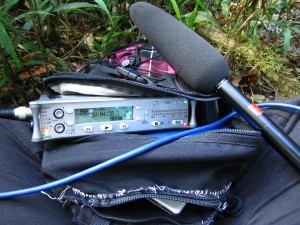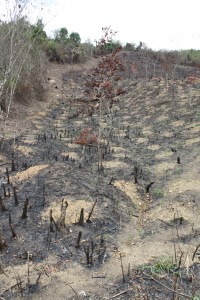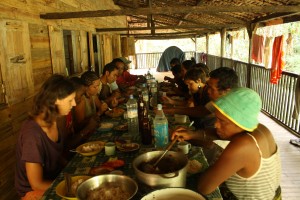Nowadays, her research focuses on non-invasive census techniques, based on vocal fingerprints, as a mechanism for monitoring vocalizing animals’ groups and lemur populations in the wild. Valeria was awarded grants from the CRT Foundation (Master dei Talenti della Società Civile), is a PCI fellow, and is a CO-PI for a Margot Marsh funded grant. She participated in writing several funded projects for conserving Malagasy wildlife, collaborating with different international organizations including GERP and Association Mitsinjo.
When did you first get interested in working with lemurs and conservation and what motivated you to undertake this work?
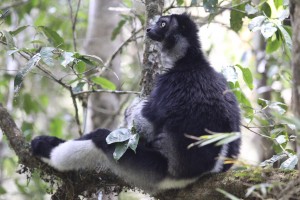
What projects are you currently working on that relate to lemur or environmental conservation?
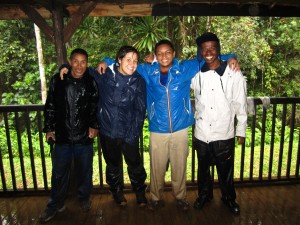
The focus of my research is still the indri (Indri indri), the largest living lemur. Due to its restricted geographic range and low population densities, the indri is listed as Endangered, and is considered one of the World’s 25 Most Endangered Primates. Improving the conservation outlook of the indri will require further knowledge about this species and its habitat. But we also need programs that will enhance education, awareness and will promote capacity building among the local people.
Finally, I am the distance-learning tutor to several PhD students from different Comorian and Malagasy Universities, in the frame of the EU ACP Edulink II EGALE Project (“Gathering Universities for Quality in Education”; Contract NFED/2012/320-117). This project aims to train qualified native human resources in the field of sustainable agriculture and food security.
 What is a typical day like for you? What is your day like when you’re working in the field?
What is a typical day like for you? What is your day like when you’re working in the field?
A typical day in the forest mirrors the daily indri routine! Which means, my day consists of getting up at about 4:30 – 5:00 AM (depending on the time of year), eating breakfast and packing survey equipment (audio and video recorders, microphones, GPS devices, two-way radios, etc.). We then try to find the animals by scanning their territories (indris live in family groups, actively defending their territories, so we do not use collars to follow them!) before their first morning song (these lemurs are known to emit loud long distance calls, “the song”, that can be heard at about 2 km).
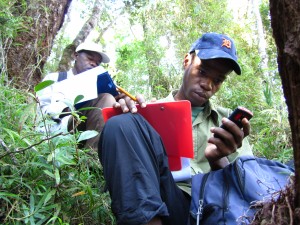
What are the hardest parts about working in Madagascar?
In my experience, the hardest part of the work is seeing that, even if we are obtaining results at a local level in building capacities and in educating people to be aware of the great potential of forests for their survival, stopping illegal deforestation and lemur hunting at a larger scale is difficult. Every year forest disturbance in Madagascar eastern rainforests doubles if compared to the previous year, and new traps and cages appear even in the protected areas. We need to be well aware that we are facing poverty while conserving biodiversity; local people’s primary concern is feeding their families, and conservation projects must take this into account. Projects should be designed with a bottom-up approach, and communities’ voices should be heard!
 What are the biggest threats facing lemurs in your line of work, and what needs to be done to alleviate those threats?
What are the biggest threats facing lemurs in your line of work, and what needs to be done to alleviate those threats?
The effectiveness of Protected Areas as a conservation tool depends on the ability to buffer plant and animal populations against anthropogenic forces (e.g., fires, deforestation, illegal logging, agriculture, etc.). In recent years, both Maromizaha and Mitsinjo SF faced the challenge of forest habitat loss, due to several factors affecting rural communities in the neighborhood (e.g., the need for charcoal, the request for new lands for farming and agriculture). As I mentioned above, we need to provide people with the capacities and the means for managing biodiversity in a sustainable way. Involving rural communities is an urgent task. Without their support conservation is just an ideal fight! I think that providing community with alternatives to forest illegal exploitation (e.g. alternative energy sources, eco-tourism, new agricultural practices, etc.) may allow us educating the public on how biodiversity is linked to human survival, and not just to species conservation. Another important aspect is, in my opinion, the involvement and training of women. In order to reach a result, women need to be educated on the values, management and sustainability of natural resources as alternative sources of livelihood.
What is the funniest or most memorable thing that has happened to you while working on lemur-related programs?
I have so many funny memories! Every experience in the field reminds me something that happened the year before with the guides, the students, or with the people working around the camp, and the greatest thing is that I can share those moments with the “Babakoto” Team (NB babakoto is the Malagasy name of the indri)! However, the biggest moment in the field happened when I got to meet Sir David Attenborough of BBC. He came to the neighborhood of Andasibe while the BBC ‘Madagascar’ documentary was being filmed. It was great to sit with him and chat about the indris’ song.
 In ten years, what do you hope to have accomplished in terms of your work in lemur conservation?
In ten years, what do you hope to have accomplished in terms of your work in lemur conservation?
First of all, I hope I will continue working with the team to fight lemur hunting and habitat loss. I hope that community involvement through national and international Partnership will lead to a reduction of forest loss in both Maromizaha and Mitsinjo Forests. Regarding my research, I am quite confident that studying indris’ songs and other lemurs’ vocal repertoires will shed light about the demography, sociality, group-living and language evolution, and will provide important insights to develop non-invasive census techniques for wild vocal animals. I hope that our methods will contribute to a deeper understanding of how we can manage wildlife though community-based effective actions.
How can people across the world help save lemurs and help your work?
I think that everyone could contribute to lemurs’ survival by few simple, undemanding steps. Donations to non-profit organizations, especially local ones, are a fundamental means to finance actions in Madagascar. Several institutions across the world have “adopt-a-lemur” programs or other campaigns to raise funds. Another important step can be visiting zoos and supporting their in situ conservation programs. Moreover, choosing ecotourism over traditional vacation represents another important way to contribute to environment safeguard. Getting more particular to the activities I am involved with: donations to U Onlus or to GERP, volunteering in Madagascar or from home, students’ internships, and “adopt-a-lemur” campaigns. Another important aspect of my work is involving Malagasy collaborators in writing grant proposals or projects.
Take Action
- Valerie recommends GERP, Association Mitsinjo, Fanamby, and her non-profit organization: U Onlus!
- Learn more about Valerie and her research!


